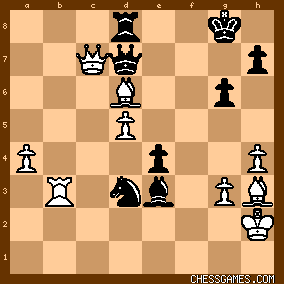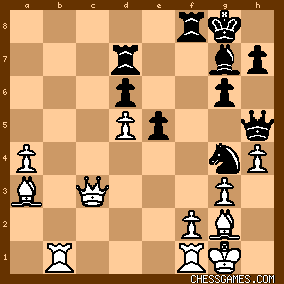| Apr-16-06 | | Hesam7: <Resignation Trap: Black missed 27...Ng4! 28.h3 Nxf2! 29.Rxf2 Rxf2, played 27...e4? instead, and Smyslov finished off his opponent with his usual efficiency.> I disagree I think 27... Ng4 still loses, but since White should be very careful afterwards, one can not ignore its practical value. I will post the full analysis later but this is the start: 27... Ng4 28. h4! [28. h3? Nxf2 =] Nxf2 29. Qc2! [This is not possible when White plays 28. h3?] And now Black has 4 main replies:
[A] 29... Rdf7
[B] 29... Ng4
[C] 29... Bh6
[D] 29... e4 |
|
Apr-17-06
 | | tamar: <Hesam7> Option D looked to be the most active, but Shredder found a mating sequence in about 5 minutes. 28 h4 Nxf2 29 Qc2 e4 30 Qc6 
click for larger view the hanging rook on d7 is Black's most serious problem and turns the tide back to White before Black can threaten anything. 30...Rdd8 31 Bxd6 Rf6 32 Rxf2 Rfxd6 
click for larger view
33 Qxd6! Rxd6 34 Rb8+ Bf8 35 Rbxf8+ Kg7
36 Rf2-f7+ Kh6 37 Rh8 mating in a few.
|
|
Apr-17-06
 | | tamar: Smyslov had an added incentive to beat Geller.
The previous year they had tied for the Soviet Championship, and in the playoff Geller played very cagey, drew 6 games, and won as Black in the 7th when he caught Smyslov with a temporary knight sacrifice to claim the Championship. Smyslov vs Geller, 1955 |
|
| Apr-17-06 | | Hesam7: <tamar> Thanks for the background. The following line is not so clear, I will look into it later: 27... Ng4 28. h4 Nxf2 29. Qc2 e4 30. Qc6 <Qg4> 31. Bxd6 Bd4 |
|
Apr-18-06
 | | tamar: In the line 27... Ng4 28. h4 Nxf2 29. Qc2 e4 30. Qc6 30...Qg4
31. Bxd6 Bd4
I hadn't considered 30...Qg4, thinking it takes away a square from the knight, but it is clearly Black's best line. Now Shredder finds an advantage for White, but it is full of twists and turns, and I am not sure either player could have found it over the board. 
click for larger view32 Rb4 Be3
33 Rb3 Nd3+
34 Kh2 Rxf1
35 Bxf1 Rd8
36 Qc7 Qd7
37 Bh3! A trick, but Black has one too. 
click for larger view
37...Qxd6
38 Be6+ Kh8
39 Qc3+ Ne5
40 Qxe3 Qxd5 Black's trick.
41 Bxd5 Ng4+
42 Kh3 Nxe3
43 Bxe4 Nc4 
click for larger view -2.63/20 |
|
| Apr-18-06 | | sneaky pete: After 27... Ng4 28.h4 Nxf2 doesn't seem as called for as after 28.h3 .. when the knight is under attack anyway. Instead 28... e4, activating Bg7, threatening .. e3 in some lines and Ng4-e5-f3+ in other lines (e.g. after 29.Qc6 Ne5 black is already better) would lead to a messy position and thereby offer black good practical chances. If 29.Qc4 e3 and if 29.Qd2 .. again .. e3 30.fxe3 Qe5 when white must be very careful. As can be seen from his game as white against Spassky from the same event, recently discussed on this site, as well as from some later games against Tal, the genius of positional harmony Smyslov was, even at his peak, sometimes vulnerable against strong tactical va banque players. |
|
| Apr-19-06 | | Hesam7: <Sneaky pete> You are right 28... Nxf2 is not forced. My point was that while after 27... Ng4 28. h3? Nxf2 leads to draw (a nontrivial fact by the way) the same does not happen when White plays 28. h4!. Your suggestion is very interesting my guess is that White's best continuation is: 27... Ng4 28. h4 e4 29. Qc4 e3 30. f4
<tamar> Thanks for the analysis, looks convincing. I will try to post a full analysis of 27... Ng4 later. Does this game appear somewhere in chess litrature? |
|
Apr-19-06
 | | tamar: <sneaky pete> In your line, White would do best to keep the Black Queen out of e5, so after 27... Ng4 28.h4 e4 29 Qb4 (or possibly 29 Qc4, either move anticipates 29...e3 by attacking the knight laterally) 29...e3 30 fxe3 Nxe3
(impossible is 30...Qe5 because the knight would be hanging) 31 Rxf8+ Bxf8 32 Qe4 Re7 33 Qf3 and White is happy to exchange because of the a pawn. 
click for larger view |
|
| Apr-19-06 | | Hesam7: After
27... Ng4 28. h4! [28. h3 Nxf2! =]

click for larger viewBlack has three options:
[A] 28… e4 29. Qd2 e3 30. fxe3 Qe5 31. Rxf8 Bxf8 32. Qe1 Qxe3 33. Qxe3 Nxe3 34. Bh3 Rd8 35. Be6+  [B] 28… Qf5 29. Qc4
[B1] 29… Nxf2 30. Qc6 Rdf7 31. Bxd6 Rf6 32. Bxf8!! Rxc6 33. dxc6 Bxf8 34. Rb8  [B2] 29… h5 30. a5 Bh6 31. Be4 Qf7 32. a6 Rc7 33. Qd3 Nxf2 34. Bxd6 Nxd3 35. Rxf7 Be3 36. Kh1 Rcxf7 37. Bxf8 Kxf8 38. Bxd3  [C] 28… Nxf2!? 29. Qc2! [29... Rdf7?? 30. Bxd6  ] ]
[C1] 29... Ng4 30. Bh3 Rdd8 31. Qc7 Rxf1 32. Rxf1 Rf8 [32… Ra8? 33. Bxd6  ] 33. Qxd6 Rxf1 34. Bxf1 h6 [34… Qf5 35. Qe6 Qxe6 36. fxe6 ] 33. Qxd6 Rxf1 34. Bxf1 h6 [34… Qf5 35. Qe6 Qxe6 36. fxe6  ] 35. Qe6 Kh7 36. Be2 Qf5 37. Qxf5 gxf5 38. d6 ] 35. Qe6 Kh7 36. Be2 Qf5 37. Qxf5 gxf5 38. d6  [C2] 29... Bh6 30. Rbe1 [30. Rxf2? Be3  ] 30… Ng4 [forced] 31. Rxf8 Bxf8 [31… Kxf8? 32. Bh3 Qf5 (Note that 32… Rf7 loses to 33. Qc8+) 33. Rf1 Be3 34. Kg2 Bf2 35. Qc8+ Kg7 36. Bxg4 Qxg4 37. Rxf2 ] 30… Ng4 [forced] 31. Rxf8 Bxf8 [31… Kxf8? 32. Bh3 Qf5 (Note that 32… Rf7 loses to 33. Qc8+) 33. Rf1 Be3 34. Kg2 Bf2 35. Qc8+ Kg7 36. Bxg4 Qxg4 37. Rxf2  ] 32. Bh3 Rf7 [32… Rd8? 33. Rf1 Nh6 34. Qc7 ] 32. Bh3 Rf7 [32… Rd8? 33. Rf1 Nh6 34. Qc7  ] 33. Qe2 Nf6 34. Be6 ] 33. Qe2 Nf6 34. Be6  [C3] 29... e4 30. Qc6 Qg4! [30… Rdd8 and 30… Rdf7 both can be met with 31. Bxd6. Against 30… Rfd8 31. Kxf2 wins ] 31. Bxd4 Bd4 32. Rb4 Be3 33. Rb3 Nd3+ 34. Kh2 Rxf1 35. Qc8+ [tamar I think this is better than your line] Kg7 [35… Kf7? 36. Qf8 #] 36. Bxf1 Qf5 37. Bg2 Nf2 38. Bf8 Kf7 39. Bb4 Ng4 40. Kh1 Bh6 41. d6  [Black can not defend against Rb1-f1] 41… Bf8 42. Rb1 e3 43. Rf1 Nf2+ 44. Kg1 Qe6 45. Qc6 Rxd6 [Forced, Bd5 was coming] 46. Bxd6 Qxd6 47. Qf3 Kg7 48. Qxe3 Ng4 49. Qc3 Ne5 [Black can not defend against Rb1-f1] 41… Bf8 42. Rb1 e3 43. Rf1 Nf2+ 44. Kg1 Qe6 45. Qc6 Rxd6 [Forced, Bd5 was coming] 46. Bxd6 Qxd6 47. Qf3 Kg7 48. Qxe3 Ng4 49. Qc3 Ne5  |
|
| Dec-03-15 | | zydeco: It seems hard to resist 23....f4.
22.b4 is a nervy move. Basically, Smyslov announces to Geller that he's not at all worried about the coming kingside attack. So he takes a tempo to get his trumps out on the queenside before worrying about defense. |
|
| Sep-02-17 | | ewan14: Why not 17.... B x b1 ( rook ) ? |
|
| Sep-02-17 | | ughaibu: My guess is that Geller didn't like Nb7 in reply. |
|
| Sep-02-17 | | Nerwal: <Why not 17.... B x b1 ( rook ) ?> It doesn't win but rather lose material after 18. ♘b7. 18. ♘e6!? fxe6 19. ♕xb1 also gives excellent compensation for the exchange. |
|
| Sep-02-17 | | ewan14: Thanks |
|
| Jul-31-19 | | King.Arthur.Brazil: After 38...♖f8 39.♕e6+ ♔h8 40.♖xf6
♗xf6 41.♖xf6 ♕d1+ 42.♔h2 ♖xf6 43.♕xf6+ ♔g8 44.♕xe5 ♕xa4 45.d6 ♕d7 46.♗d5+ ♔f8
47.♕h8# |
|





